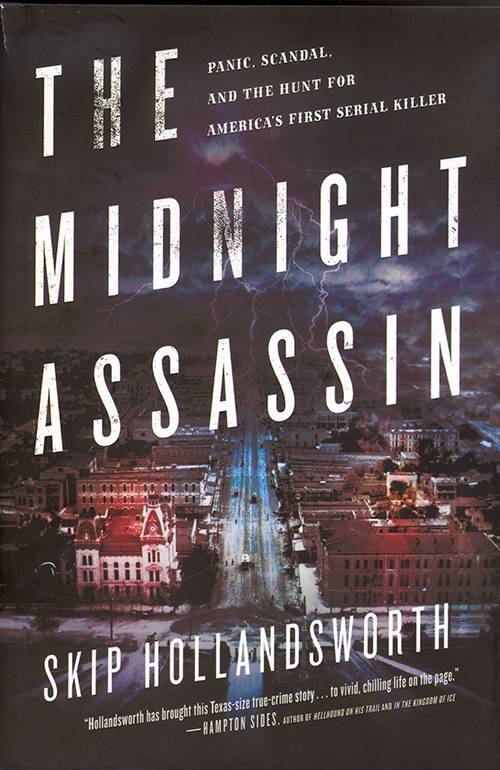Psycho Killer

The Midnight Assassin: Panic, Scandal, and the Hunt for America’s First Serial Killer,
by Skip Hollandsworth
New York: Henry Holt and Company, 2016
336 pp. $30 cloth
Reviewed by
Doug J. Swanson
Veteran readers of Texas Monthly have long hoped for a book from Skip Hollandsworth, whose career at that journal has featured lurid and fascinating dispatches from the rich world of Lone Star crime. Now the book has arrived, and it was well worth the wait.
The Midnight Assassin: Panic, Scandal, and the Hunt for America’s First Serial Killer traces the bloody path of a murderer—or murderers—who stalked Austin more than 130 years ago. It’s a great tale, spun by a master storyteller who spent more than a decade pulling it together.
The first victims were black, and the savagery of their slayings alarmed many citizens. But when the killer turned to butchering white women, widespread panic took hold.
“For almost exactly one year, the Austin killer crisscrossed the entire city, striking on moonlit nights, using axes, knives, and long steel rods to rip apart women from every race and class,” Hollandsworth writes. “On Christmas Eve of 1885…he brought Austin to the brink of chaos when, in the space of an hour, he slaughtered two prominent women in separate neighborhoods, cutting up their bodies in their backyards before vanishing in the briefest imaginable time.”
The spate of murders became national, and sensational, news. It was in fact a reporter who gave the killer his moniker: the Midnight Assassin, who “strides at will over Austin’s sacred soil.” The Austin Daily Statesman’s headline for the Christmas Eve murders was, “BLOOD! BLOOD! BLOOD!”
Though at least a dozen men were eventually arrested, the charges didn’t stick. Detectives and “alienists”— experts in criminal perversion and insanity—could offer little more than airy theories. “They are abnormal and unnatural, as compared with ordinary crimes among men,” said John Robertson, the mayor of Austin during the killing spree. “No one, not even the expert, skilled in the detection of crime, can find a plausible motive.”
At one point, the so-called experts even suspected the Austin madman had established an international branch: some posited that London’s notorious Jack the Ripper learned his murderous craft in Texas’s capital city. This promotion in killer class seemed far-fetched. “If he was obsessed with ripping apart women,” Hollandsworth says, “wouldn’t he have stopped somewhere in between Texas and England to do a few killings?”
Though a tale of serial murder, this also unfolds as a story of the city itself—a welcome element for readers. Austin is of course steeped in lore, but—like other Texas metropolises—it often seems too busy creating itself to pay much attention to the past. (If Austin really cared about its historic glories, the Armadillo World Headquarters would stand yet.)
Today’s traffic-clogged mecca for musicians, politicians, academicians, techies, and hipsters began its life as little more than a cow town on the Colorado. Those were, a local newspaper quipped, “the good old days of rawhide and chile con carne.” As Hollandsworth writes, “There was practically no industry at all except for a sawmill. About the only businesses that prospered were the saloons, the gambling dens—the city directory listed twenty ‘professional gamblers’—and the brothels.”
Soon, however, the railroad connected the town to the rest of the world, and the promoters, real estate speculators, and boosters seized their moment. Drawing heavily on newspaper accounts of the day, Hollandsworth brings to life Austin’s Gilded-Age formative years, when the splendid Driskill Hotel went up, and a new state capitol was being built at the top of Congress Avenue. Needless to say, a roaming, unstoppable serial killer was bad for business.
Those readers whose tastes run to true crime—and the writers of it who cashed fat advance checks back in the day—know well that genre peaked a couple of decades ago. Mystery fiction has stayed fairly strong, but mystery non-fiction has gasped for life. Literary pathologists determined the cause of near-death to be an overdose of schlock.
But we now seem to be enjoying a renaissance of sorts, at least in electronic media. Serial was a 2014 podcast sensation, and the documentary Making a Murderer led last year to a national epidemic of Netflix binging. Both showed the inner workings of our cumbersome, recondite, and sometimes deeply flawed criminal justice machinery.
Perhaps the book industry will jump on the nascent trend. And if so, maybe The Midnight Assassin will, by virtue of its deep research and compelling readability, help lead the revival.
As with every such story, this book turns on a central question—who did it? The answer won’t be found in this review. One wouldn’t want to spoil the mystery.
Doug J. Swanson is the author of Blood Aces: The Wild Ride of Benny Binion, the Texas Gangster Who Created Vegas Poker. He is working on a history of the Texas Rangers.
